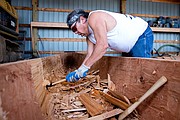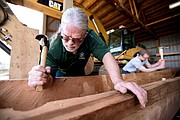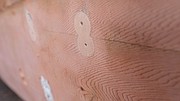Reconnecting with the canoe
BETHANY BLITZ/Staff Writer | Hagadone News Network | UPDATED 9 years, 8 months AGO
A giant log sits in a warehouse on the Coeur d’Alene reservation. It is destined for greatness. Protected by a tin roof, the log waits for its transformation into a shovel-nosed canoe.
It will be the first canoe built by the Coeur d’Alenes since the missionaries came more than 150 years ago. It marks the start of the Tribe’s effort to bring back this piece of its historical culture.
The canoe will travel by river to Kettle Falls to meet with neighboring tribes. The tribes will trade and call the salmon home as their ancestors did.
The Upper Columbia United Tribes started a project last summer that invited all five tribes — the Kalispell, the Spokane, the Confederated Tribes of the Colville Reservation, the Kootenai, and the Coeur d’Alene Tribes — to build their own dug-out canoes.
“All of these tribes are water tribes,” said Marc Gauthier, the United Tribes' forest practices coordinator. “They have lost that connection to the canoes.”
Gauthier started this project when he saw other tribes in Washington bring back the canoe. He saw how it brought people together and decided to bring a similar project to the United Tribes.
How To Build
A Canoe
Step 1: Get a Tree
The best trees for making canoes are old-growth trees. These are trees that tend to be more than 300 years old. They grow so tall that they have to drop their lower branches. As the tree continues to grow, it covers the knots where the branches used to be.
What you get is a very long section of trunk uninterrupted by branches. These trees are very hard to come by because logging companies only use smaller trees now. To have a stand of old-growth trees is rare.
Gauthier heard two members of the Quinault tribe were harvesting their 80-acre allotment of old-growth cedars. They let the United Tribes buy six of them at cost to make canoes.
Gauthier got to watch the trees fall and picked out the best ones with the straightest grain. He arranged for two log trucks to carry the logs to the Colville reservation.
The Colvilles lent the project equipment to get the logs off the trucks and offered to take care of them and water them until they could be transported to the different tribes. Each of the five tribes got one log, but the Colvilles got two because they have two separate communities.
The Coeur d’Alene Tribe received its log last August. It was about 700 years old, 28,000 pounds, 45 feet long and more than 5 feet in diameter.
Once all the tribes have completed their canoes, they will row them to Kettle Falls in Washington and meet each other June 17. There, the tribes will have a reception and celebration. The next day they will perform a traditional salmon ceremony.
Once the tribes got their logs, they had to do a lot of research about how to make a canoe. A lot of that information was erased from the Coeur d’Alenes’ history, so they talked to coastal tribes and did a lot of research at the JayHawk Institute — which serves Northwest native art and history.
Step 2: Name it
In the beginning stages of the project, it was important to keep the log moist. The Tribe covered it with burlap sacks and put a drip system on it. Vince Peone, a lead wildlife technician for the Tribe who has taken a leadership role in building the canoe, spent a lot of time covering and uncovering the log to look at it and work on it.
The first time he uncovered the log, he found a little frog. It would hop away and Peone would cover the log back up. Every time he uncovered the log, the frog was there. He told the others about the frog and they agreed to name the boat “Warx,” meaning frog in Coeur d’Alene.
“This log is very special to our tribe. The canoe project, to me, is like the past waking up our future, something that’s been gone, that was taken from you; it hurts,” Peone said. “The spiritual deity of the boat woke up as soon as we saw it.”
Jeffery Jordan, a fisheries biologist for the Tribe and another key member of the canoe effort, decided to hand-make some tools specifically to carve out a canoe.
He used cherry wood and forged blades from steel. He made a few adzes — pick-like tools with flat, curved blades — a curved draw knife and a scorp, which is a right-angled gauge carving tool.
“We’re knocking on culture’s door,” Jordan said. “It’s an honor to be able to work on it. I like to do things with my hands and see the progress and make the tools and help where I can.”
Step 3: Start at the bottom
Carve the outside of the canoe first. This may require a chain saw at first, then use of hand tools. Establish a center line and make the sides as even as possible.
Decide on either a rounded floor, like the Coeur d’Alenes have chosen, or a flat floor. Once the shape is carved, sand it. The Tribe has a tapered shape to its canoe, where the ends are about 5 inches higher than the center.
Measured pegs are put in the walls of the canoe to ensure workers don’t carve the walls too thin once the canoe is flipped upright.
The Coeur d’Alenes decided to make the walls of their canoe three-quarters of an inch thick and the floor will be 1.5 inches thick. They drilled rows of holes 12 inches apart down the length of the canoe. The holes are deeper than the pegs so when carving out the inside, you can see the holes before you hit the pegs. This ensures the walls and floor aren’t carved too thin.
John Zinser is the United Tribes’ project consultant. He helped the tribes research these different techniques. He said some coastal carvers helped them out a lot and told them about things they never would have thought of.
“One thing we got out of it was you never stray from tradition,” Zinser said. “It’s hard because a lot of this stuff is forgotten, but as much as possible you want to look at how it’s been done in the past. You don’t want to try and reinvent the wheel because this is technology that was fully developed.”
This has become a community project a lot of people have contributed to. Peone said hundreds have stopped by to help and learn about what is going on. They’ve had kids from the tribal school visit, they’ve had college students help out, the chairman stopped by, even some elders come to see the progress and hang out.
“We put our blood, sweat and tears into this,” Peone said. “It’s really special to see the young people come out and put their time in it and help out. They enjoy doing it. They like to help out. They all want to ride in it when it’s done. It’s really nice to see that.”
Peone is proud to have his kids help with the project as well. He wants them to be able to tell the story about how they helped build this canoe with their dad.
“It’s just a really huge project for our tribe,” Peone said. “It just feels like this boat is waking up our future.”
Step 4: Flip it
As the Coeur d’Alene Tribe found out, it takes about 12 people and some heavy machinery to flip the partially carved log.
“It’s a big step in the process,” Zinser said. “When you flip it over, it’s like ‘Wow, there it is, it’s a canoe.’ It’s cool because you’ve never seen the canoe like this before, it’s always been upside down.”
To get the majority of the wood out from the middle of the canoe, The Tribe decided to divide the interior into two long beams and split them out the bottom.
They made three big cuts down the length of the canoe, not too deep, making the two beams. Then they carved holes at the end of the cuts. They inserted a big wedge and split the beams out of the canoe.
All the extra wood that came out was given to students to carve. Coeur d’Alene Tribal Students have made paddles from the excess, and they are currently making model canoes, too.
Once the beams are out, it’s time to address the cracks on the outside of the canoe. Where the cracks start and end, insert butterflies. Not the insect; a butterfly is a piece of flat wood that looks like the number 8. They are put in where the cracks start and end to prevent the cracks from spreading.
Now it’s time to carve out the bottom.
Use the tools that Jordan made to carve down to the holes you drilled earlier. Be very cautious and keep carving until you reach the pegs. From here, carve out everything between the rows of pegs. Carve in straight lines. Uniform thickness is essential.
This is as much as The Tribe has completed. The Coeur d’Alenes are still carving out the bottom and will need to address knots in the wood. Knots can radiate cracks. They will carve out the knots and replace them with other wood.
Step 5: Stretch and finish
To taper the canoe and round out the walls, you stretch the boat. This allows you to get the classic canoe shape without cutting across grain lines. The eye-shape of a canoe allows it to maneuver more easily. With bowed walls, a canoe is also more stable in the water.
To stretch the canoe, put the ends on blocks so it sits above the ground. Fill it with about 10 inches of water and put hot engine blocks in it. This creates steam. Build fires at either end of the canoe and let it steam for about a day.
However, because there are so many cracks and knots in their canoe, the Coeur d’Alenes aren’t sure they will stretch their boat. They might texture it instead. Jordan said they were looking at different designs and found one that looked like the pattern of a golf ball. He said this would help the boat glide better and help with water resistance.
Gauthier, the guy who initiated this whole project, said the goal was to have the youth use these canoes, do a canoe journey to the salmon grounds, bring back trade and revitalize the Native American culture.
“Just seeing the tribal members work these canoes, I see it’s in their blood,” he said. “I really believe this and the other efforts with the sturgeon canoes the Coeur d’Alenes are doing is going to ensure the Coeur d’Alenes are canoe people for long into the future.”
Step 6: Go back to the water
The Tribe’s canoe is about 34 feet long and can seat about 10 adults. The gathering of the Upper Columbia United Tribes is scheduled for June 17. Some tribes have longer journeys than others. It will take the Coeur d’Alenes about 10 days to get there.
Some tribes might meet up along the way and paddle part of the journey together.
“We are all water people; salmon was our mainstay. Everyone in our tribes would go to Spokane Falls to fish,” Peone said. “My hopes would be that the tradition would come back into place and we have more tribal involvement in building canoes, water-potato digs and more traditional ways of life.”
ARTICLES BY BETHANY BLITZ/STAFF WRITER

Praise for the police
Cd’A department holds annual awards ceremony
COEUR d'ALENE — The Coeur d’Alene Police Department awarded 38 sworn and non-sworn members of the police department Monday, for their commitment to the safety of Coeur d’Alene.

Reconnecting with the canoe
Project unites tribe members with their cultural heritage as ‘water people’
A giant log sits in a warehouse on the Coeur d’Alene reservation. It is destined for greatness. Protected by a tin roof, the log waits for its transformation into a shovel-nosed canoe.

Cutthroat Trout Conservation Project resumes
Plan aims to move pike from Windy Bay in Lake Cd’A to Cougar Bay
PLUMMER — The Coeur d’Alene Tribe and Idaho Department of Fish and Game are resuming their Cutthroat Trout Conservation Project this month.







